Treatments
Written by Olivia Zoph
Doctor Know features an array of treatments drawn from real-world practice and cutting-edge research. Some of these tools have been in use for decades. Others are have just come to market. And many are still in research labs but promise to transform medicine in the coming decade.
Click on the headings below to see more information about each diagnostic test. Explore them all!
ChemotherapyClick for more info
 Chemotherapy, also called Chemo, is a medication used to fight cancer. To understand how chemotherapy works, we have to understand cancer. Cancer occurs when the errors in our cell's DNA start to add up. DNA (deoxyribonucleic acid) is a cellular molecule that contains the cell’s genetic information. When there are errors in the instruction template, cells start to misbehave. Cells that stop playing by the rules sometimes lose control of growth and division. They divide rapidly without organization. Cancer cells are very selfish and take the space and nutrients neighboring cells need to survive and grow. Advanced cancer may travel in the body to affect distant tissues through a process called metastasis.
Chemotherapy, also called Chemo, is a medication used to fight cancer. To understand how chemotherapy works, we have to understand cancer. Cancer occurs when the errors in our cell's DNA start to add up. DNA (deoxyribonucleic acid) is a cellular molecule that contains the cell’s genetic information. When there are errors in the instruction template, cells start to misbehave. Cells that stop playing by the rules sometimes lose control of growth and division. They divide rapidly without organization. Cancer cells are very selfish and take the space and nutrients neighboring cells need to survive and grow. Advanced cancer may travel in the body to affect distant tissues through a process called metastasis.
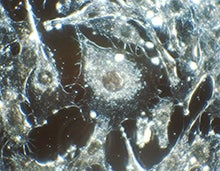 Treating cancer is difficult because cancer cells are our own misbehaving cells. Chemotherapy targets the features of cancer that have gone wrong: uncontrolled growth and division. There are several types of chemotherapy drugs. Most of them act by killing cells that divide quickly. Chemotherapy is slowly delivered directly into a patient’s blood supply through an IV. This allows the drug to travel throughout the body in search of rapidly dividing cancer cells.
Treating cancer is difficult because cancer cells are our own misbehaving cells. Chemotherapy targets the features of cancer that have gone wrong: uncontrolled growth and division. There are several types of chemotherapy drugs. Most of them act by killing cells that divide quickly. Chemotherapy is slowly delivered directly into a patient’s blood supply through an IV. This allows the drug to travel throughout the body in search of rapidly dividing cancer cells.
Unfortunately, chemotherapy also affects our normal cells that divide quickly. This explains the large number of side effects patients have while taking chemo. Side effects of chemo often include hair loss, nausea and reduced immune function (so patients can get sick more easily).
Chemotherapy can be used by itself or with other cancer treatments, like radiation. There are many different treatment programs for different cancers. Treatments like chemo can vary in how well they work based on the cancer cell type and mutations, among other factors. Chemotherapy can be used to cure or to improve the life of someone with advanced cancer.
Gene Therapy
 Within our cells, special molecules of DNA (deoxyribonucleic acid) contain instructions for the cell. The information in DNA is decoded and used to make proteins. Proteins are the workhorses of our cells - they get things done. Changes in proteins can lead to dramatic changes in the cell. There are many diseases that are a result of errors or mutations in DNA that lead to changes in protein production.
Within our cells, special molecules of DNA (deoxyribonucleic acid) contain instructions for the cell. The information in DNA is decoded and used to make proteins. Proteins are the workhorses of our cells - they get things done. Changes in proteins can lead to dramatic changes in the cell. There are many diseases that are a result of errors or mutations in DNA that lead to changes in protein production.
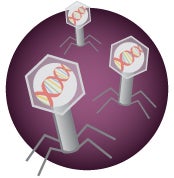 Gene therapy uses DNA to treat diseases caused by mutated DNA. After the mutated DNA or protein problem is found through testing, the disease is properly identified. The, scientists use viruses, called vectors, to deliver new DNA to the cells. The new DNA doesn't have the patient's mutation. This means the DNA causes the cell to produce the right proteins, treating the patient's disease. These proteins are called therapeutic proteins, because they treat the problem at hand. Gene therapy can be used to replace damaged DNA with functional DNA. It may also be used to increase production of an important protein by a transferring a gene that encodes for that protein.
Gene therapy uses DNA to treat diseases caused by mutated DNA. After the mutated DNA or protein problem is found through testing, the disease is properly identified. The, scientists use viruses, called vectors, to deliver new DNA to the cells. The new DNA doesn't have the patient's mutation. This means the DNA causes the cell to produce the right proteins, treating the patient's disease. These proteins are called therapeutic proteins, because they treat the problem at hand. Gene therapy can be used to replace damaged DNA with functional DNA. It may also be used to increase production of an important protein by a transferring a gene that encodes for that protein.
Irradiate
 Radiation is a therapy used to fight cancer. Cancer occurs when mutations cause our own cells to stop playing by the rules and undergo uncontrolled growth and division. They divide rapidly without organization. Cancer cells are very selfish and take the space and nutrients neighboring cells need to survive and grow. A collection of cancer cells is called a tumor. Advanced cancer may travel in the body to affect distant tissues through a process called metastasis.
Radiation is a therapy used to fight cancer. Cancer occurs when mutations cause our own cells to stop playing by the rules and undergo uncontrolled growth and division. They divide rapidly without organization. Cancer cells are very selfish and take the space and nutrients neighboring cells need to survive and grow. A collection of cancer cells is called a tumor. Advanced cancer may travel in the body to affect distant tissues through a process called metastasis.
 Radiation therapy zaps cancer cells with high-energy radiation, such as x-rays, gamma rays, and charged particles. This high-energy radiation damages DNA. Cancer cells already have errors in their DNA. But radiation pushes them over the edge into cell death. Radiation can directly damage DNA or create free radicals that damage DNA. Radiation is used to shrink tumors and kill cancer cells. Similar to chemotherapy, radiation can be used to remove or lessen the effects of cancer.
Radiation therapy zaps cancer cells with high-energy radiation, such as x-rays, gamma rays, and charged particles. This high-energy radiation damages DNA. Cancer cells already have errors in their DNA. But radiation pushes them over the edge into cell death. Radiation can directly damage DNA or create free radicals that damage DNA. Radiation is used to shrink tumors and kill cancer cells. Similar to chemotherapy, radiation can be used to remove or lessen the effects of cancer.
Radiation therapy is given in two ways. High-energy radiation can be directed at the cancer cells from outside the body. Or radioactive material can give off radiation in near the cancer cells. Doctors called radiation oncologists decide which type of radiation to use. They must consider the type of cancer, tumor size, cancer location, and many other factors in this decision. Radiation can also harm normal cells. This leads to the side effects of radiation, including fatigue and nausea. To minimize side effects, radiation therapy should be limited to the smallest area possible.
Medicate
 Medications are drugs that act in the body to treat or prevent disease. Some drugs are taken from plants or animals and others have been created in a lab. Medications exert their effects by interacting with disease processes. There are many different drug classes that each have a different effect in the body.
Medications are drugs that act in the body to treat or prevent disease. Some drugs are taken from plants or animals and others have been created in a lab. Medications exert their effects by interacting with disease processes. There are many different drug classes that each have a different effect in the body.
The way you take a drug is called its "administration route". When taking a medication, it needs to travel from outside of the body to its target tissue, where it will help fight the disease. Most medicines are delivered by mouth as a pill (like vitamins) or a liquid (like cough syrup). There are many other ways drugs can get into the body. Some examples of administration routes include breathing the drug in, applying it directly to the skin, or injecting the drug directly into the blood system.
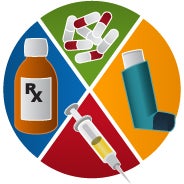 Regardless of how the drug enters the body, it needs to travel to its target tissue in order to work. Even if the target tissue is in the mouth or throat, a swallowed pill must do a lot of traveling before it starts working on the mouth. For example, bad sore throats may be caused by a bacterial infection. When a doctor suspects a bacteria is causing the symptoms, they may prescribe an antibiotic medicine. Antibiotics are used to kill or stop bacteria from growing. Antibiotics are commonly taken by mouth in pill form. For medicines that are ingested, they must travel down to the stomach and intestines where they can be absorbed into the blood stream. Once the drug is in the patient’s blood it needs to get to its target tissue to work effectively – in this case the throat, where the bacteria are growing.
Regardless of how the drug enters the body, it needs to travel to its target tissue in order to work. Even if the target tissue is in the mouth or throat, a swallowed pill must do a lot of traveling before it starts working on the mouth. For example, bad sore throats may be caused by a bacterial infection. When a doctor suspects a bacteria is causing the symptoms, they may prescribe an antibiotic medicine. Antibiotics are used to kill or stop bacteria from growing. Antibiotics are commonly taken by mouth in pill form. For medicines that are ingested, they must travel down to the stomach and intestines where they can be absorbed into the blood stream. Once the drug is in the patient’s blood it needs to get to its target tissue to work effectively – in this case the throat, where the bacteria are growing.
Sometimes when patients take these medicines, they have varied effects. In the body, drugs may attach to tissues or molecules similar to those they are targeting. Attaching to molecules on accident is called non-specific binding. Binding to these tissues and molecules may change the cell in other ways and lead to the side effects that patients experience.
Once the drug reaches its target tissue, drugs bind to molecules or special landing zones on cells called receptors. When the drug binds to a molecule or receptor, it can alter that cell's processes. For example, antibiotics bind to bacterial molecules. This changes the molecule's structure or prevents the bacteria from growing.
Modulate Immunity
 The immune system is our body’s defense against foreign invaders. It attacks and kills bacteria and other invaders to keep our body healthy. Our immune system is working constantly to secure our body from outside attack. The key to the immune system’s success is its ability to distinguish between “self” and “non-self.” Once a foreign invader is identified, the body is able to respond to it.
The immune system is our body’s defense against foreign invaders. It attacks and kills bacteria and other invaders to keep our body healthy. Our immune system is working constantly to secure our body from outside attack. The key to the immune system’s success is its ability to distinguish between “self” and “non-self.” Once a foreign invader is identified, the body is able to respond to it.
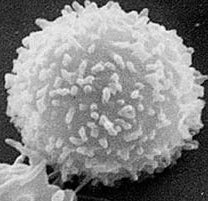 There are many cells in the immune system that work together to protect the body from sickness. By producing specific immune cells, antibodies, toxins and other molecules, we can change the immune system response. The immune cells talk to each other using molecules called cytokines. There are many different cytokines immune cells use. When cells need help from other immune cells, they release specific cytokines to call them into action. We can directly add these cytokines to a patient's system or give a drug that increases cytokine production. This boosts the immune system into overdrive to fight off invaders.
There are many cells in the immune system that work together to protect the body from sickness. By producing specific immune cells, antibodies, toxins and other molecules, we can change the immune system response. The immune cells talk to each other using molecules called cytokines. There are many different cytokines immune cells use. When cells need help from other immune cells, they release specific cytokines to call them into action. We can directly add these cytokines to a patient's system or give a drug that increases cytokine production. This boosts the immune system into overdrive to fight off invaders.
On the other hand, there are times when we want to calm the immune system down. Autoimmune disease is the third major category of illness in the United States (behind cancer and heart disease). Autoimmune diseases cause the immune system to lose the ability to distinguish between “self” and “non-self”. The immune system mistakes our own cells as being foreign and attacks them. There are around 80 different types of autoimmune diseases which include: lupus, rheumatoid arthritis, and chronic fatigue syndrome. In these situations, we want to calm down the immune system. To treat autoimmune diseases, doctors can send signals that stop certain immune responses.
Phage Therapy
 You probably know that people can get sick with viral infections. But you may not know that bacteria can get sick with viral infections, too. Viruses contain molecules of DNA or RNA (ribonucleic acid). These molecules hold the information for protein assembly. Viruses are like biological pirates: they invade cells, take over the cell, and start reproducing. In this way, they unleash thousands of viruses (known as clones) that invade and take over other cells.
You probably know that people can get sick with viral infections. But you may not know that bacteria can get sick with viral infections, too. Viruses contain molecules of DNA or RNA (ribonucleic acid). These molecules hold the information for protein assembly. Viruses are like biological pirates: they invade cells, take over the cell, and start reproducing. In this way, they unleash thousands of viruses (known as clones) that invade and take over other cells.
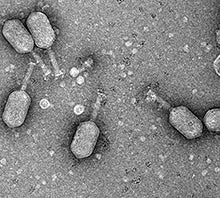 Phages, also called bacteriophages, are viruses that attack and kill bacteria. Viruses attack different cells because of the signals they express on their outside surface. This makes phage therapy very specific. Phages only attack cells that have the certain signal to which they are tuned. A bacteriophage will only attack the bacterial strain it is built to recognize. This keeps our cells and good bacteria safe from destruction by the bacteriophage.
Phages, also called bacteriophages, are viruses that attack and kill bacteria. Viruses attack different cells because of the signals they express on their outside surface. This makes phage therapy very specific. Phages only attack cells that have the certain signal to which they are tuned. A bacteriophage will only attack the bacterial strain it is built to recognize. This keeps our cells and good bacteria safe from destruction by the bacteriophage.
Bacteriophages are used to treat a person who is sick with a bacterial infection. The phages go on to attack their specific bacteria type. Antibiotics don't have that advantage. Antibiotics are also used to treat bacterial infections. But antibiotics work against larger groups of bacteria and are not as specific – so they may kill off our bad and good bacteria. Without the good bacteria to keep us healthy, we are at risk for other diseases.
Bacteriophages are very specific., This means doctors have to know what type of bacteria is causing the infection to prescribe the correct strain. This can be difficult. If doctors give a patient the wrong bacteriophage, the bad bacteria will continue to grow and cause harm. To overcome this problem, doctors prescribe phage mixtures that treat several bacterial strains at once. Another problem is that the patient’s immune system can inactivate bacteriophages. This occurs when the patient’s immune system recognizes the phage as foreign material.
Phage therapy isn't used often because it is very costly. Phages may treat bacterial infections that don't respond to traditional treatments. As bacteria become more resistant to antibiotics, phage therapy will be an important option in the future.
Pressurize
 How long can you hold your breath? We breathe in order to deliver oxygen to our cells. Our bodies feel uncomfortable when we’re not breathing because oxygen is not getting to our tissues. When you hold your breath, your cells start running out of oxygen, a condition called hypoxia. Oxygen is necessary to sustain life. Cells need oxygen in order to convert sugars into energy. When cells don’t have enough oxygen, they can’t make the energy they use to work, fight infections, and survive. Some diseases affect the amount of oxygen that gets to our cells.
How long can you hold your breath? We breathe in order to deliver oxygen to our cells. Our bodies feel uncomfortable when we’re not breathing because oxygen is not getting to our tissues. When you hold your breath, your cells start running out of oxygen, a condition called hypoxia. Oxygen is necessary to sustain life. Cells need oxygen in order to convert sugars into energy. When cells don’t have enough oxygen, they can’t make the energy they use to work, fight infections, and survive. Some diseases affect the amount of oxygen that gets to our cells.
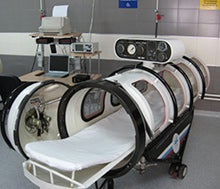 In such cases, our ability to fight disease can improve when more oxygen gets to the cells. Oxygen treatment is called hyperbaric oxygen therapy or pressurization. To increase oxygen delivery, a patient is placed in an airtight space called a pressure chamber. The regular room air we breathe is 21% oxygen. But the pressure chamber is filled with 100% oxygen and the pressure is increased to 2-4 times normal pressure. Thus, more oxygen enters the lungs and gets into to the blood. Oxygen travels around in the blood until it is delivered to the tissue. When the patient finishes a treatment and leaves the chamber, the cells and tissue return to their hypoxic state. But, even single doses of hyperbaric oxygen therapy can help cells function for several hours.
In such cases, our ability to fight disease can improve when more oxygen gets to the cells. Oxygen treatment is called hyperbaric oxygen therapy or pressurization. To increase oxygen delivery, a patient is placed in an airtight space called a pressure chamber. The regular room air we breathe is 21% oxygen. But the pressure chamber is filled with 100% oxygen and the pressure is increased to 2-4 times normal pressure. Thus, more oxygen enters the lungs and gets into to the blood. Oxygen travels around in the blood until it is delivered to the tissue. When the patient finishes a treatment and leaves the chamber, the cells and tissue return to their hypoxic state. But, even single doses of hyperbaric oxygen therapy can help cells function for several hours.
Historically, pressurization has been used for the treatment of sea divers that came out of the water too fast (decompression sickness). Hyperbaric oxygen therapy also helps treat other diseases, like serious infections.
But pressurization also has a downside. When patients breathe 100% oxygen for a long time, they can damage their lungs and other organs. When there is too much oxygen, molecules called reactive oxygen species (ROS) are formed. These molecules react a lot (bind or unbind). This may disrupt the function of cells.
Additionally, when 100% oxygen is breathed at high pressure, patients can get oxygen poisoning. Oxygen poisoning can cause nausea, dizziness, blurred vision, and even seizures. This is why careful monitoring during pressurization therapy is important.
Probiotics
 Washing your hands is a good way to avoid lots of nasty bacteria… right? Well… yes. And no. We tend to associate bacteria with sickness, but there are many of these microbes that live in harmony with our body. Many are actually good for us, so washing them away doesn't do us much benefit. Our skin and gut are covered with these tiny “good” bacteria that help protect us from bad bacteria and other microbes that could cause infection. Many areas of our bodies have happy, healthy bacteria that live with us as friends. These bacteria live in harmony with our body and keep each other from growing too much. Some bacteria in our gut also help us to digest food.
Washing your hands is a good way to avoid lots of nasty bacteria… right? Well… yes. And no. We tend to associate bacteria with sickness, but there are many of these microbes that live in harmony with our body. Many are actually good for us, so washing them away doesn't do us much benefit. Our skin and gut are covered with these tiny “good” bacteria that help protect us from bad bacteria and other microbes that could cause infection. Many areas of our bodies have happy, healthy bacteria that live with us as friends. These bacteria live in harmony with our body and keep each other from growing too much. Some bacteria in our gut also help us to digest food.
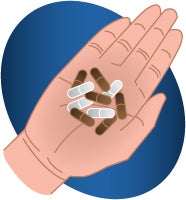 When there are more bad bacteria than good bacteria, diseases can occur. This imbalance often occurs after a patient takes antibiotics. Antibiotics kill both the bad bacteria that we want to target and the good bacteria we like. If a patient has a bacterial infection, they may receive antibiotics. But the antibiotics kill off the good gut bacteria. Without the good bacteria around, the bad bacteria may cause problems. We can take probiotics, supplements of the good bacteria, to fix this problem. Probiotics help the right bacteria find its way into our digestive tract.
When there are more bad bacteria than good bacteria, diseases can occur. This imbalance often occurs after a patient takes antibiotics. Antibiotics kill both the bad bacteria that we want to target and the good bacteria we like. If a patient has a bacterial infection, they may receive antibiotics. But the antibiotics kill off the good gut bacteria. Without the good bacteria around, the bad bacteria may cause problems. We can take probiotics, supplements of the good bacteria, to fix this problem. Probiotics help the right bacteria find its way into our digestive tract.
Prosthetics
 When you think of a prosthetic, or fake limb, you may not realize at first how long they've been around. Just imagine pirates walking around on peg legs aboard a ship. Extreme injuries and diseases can cause some patients to lose body parts – often limbs: arms and legs. We use our arms and legs to move around and to handle or move objects around us. Life can be difficult for someone missing a limb because along with the lost limb, they’ve lost these abilities. We use our limbs for almost everything. Patients with lost appendages have difficulty with daily activities, like getting out of bed, walking around, brushing their teeth, and showering, to name just a few.
When you think of a prosthetic, or fake limb, you may not realize at first how long they've been around. Just imagine pirates walking around on peg legs aboard a ship. Extreme injuries and diseases can cause some patients to lose body parts – often limbs: arms and legs. We use our arms and legs to move around and to handle or move objects around us. Life can be difficult for someone missing a limb because along with the lost limb, they’ve lost these abilities. We use our limbs for almost everything. Patients with lost appendages have difficulty with daily activities, like getting out of bed, walking around, brushing their teeth, and showering, to name just a few.
 Almost everything changes when you lose a limb. Additionally, missing body parts can have a psychological impact on the patient. Missing limbs may draw unwanted attention and be a source of embarrassment for the patient. Prosthetics are used to replace lost body parts to restore function and appearance.
Almost everything changes when you lose a limb. Additionally, missing body parts can have a psychological impact on the patient. Missing limbs may draw unwanted attention and be a source of embarrassment for the patient. Prosthetics are used to replace lost body parts to restore function and appearance.
Prosthetics are mostly used to replace arms or legs after they have been lost by trauma, disease, or defect. Technical advances have allowed scientists to develop prosthetics that are close to the real thing. Some prosthetics are almost indistinguishable from real body parts. Not only do these manufactured limbs look real, advanced models can also act real! Scientists continue to work on ways to make improve prosthetics in order to better the lives of patients who have lost limbs.
Regenerate
 A lizard in danger of being eaten can drop its tail, distracting its attacker and potentially saving its life. But what happens then? Most lizards can slowly regrow their tails through a process called regeneration. While we can't regrow our limbs, there are some tissues the human body can regenerate.
A lizard in danger of being eaten can drop its tail, distracting its attacker and potentially saving its life. But what happens then? Most lizards can slowly regrow their tails through a process called regeneration. While we can't regrow our limbs, there are some tissues the human body can regenerate.
To understand how regeneration works, you must understand what stem cells are. There are many different cell types in our body. Each cell type is special for its specific job. For example, two types of cells we have in our body are red blood cells and skin epithelial cells. Red blood cells are found in our blood, where they carry and deliver oxygen throughout our body. Skin cells have a very different job. They are flat and thin (like pancakes) and stack on top of each other in order to create a layer of protection. These cells are different in how they look and what they do. Remarkably, these two different cell types are descendants of the same cell.
 All of the cells in our bodies originated from a precursor cell that grew and divided. In a process called differentiation, signals tell cells grow and change in different ways. Differentiation leads to all of the different cell types, including red blood cells and skin epithelial cells. Before differentiation occurs, cells are referred to as stem cells. Stem cells are unique because they have the remarkable ability to change into many different types of cells. The process of differentiation is irreversible in our bodies. Hence, once a stem cell changes into a red blood cell, it will only ever be a red blood cell and it can only make other red blood cells.
All of the cells in our bodies originated from a precursor cell that grew and divided. In a process called differentiation, signals tell cells grow and change in different ways. Differentiation leads to all of the different cell types, including red blood cells and skin epithelial cells. Before differentiation occurs, cells are referred to as stem cells. Stem cells are unique because they have the remarkable ability to change into many different types of cells. The process of differentiation is irreversible in our bodies. Hence, once a stem cell changes into a red blood cell, it will only ever be a red blood cell and it can only make other red blood cells.
When a patient loses or damages his or her own cells, doctors can use stem cells from the patient to replace the damaged cells. By using the patient's own stem cells, the chance is reduced that the patient's body will react poorly to the new cells. Stem cells are exposed to cellular signals that tell them what type of cell needs to be replaced. Once the cells are grown in the lab, they can be transferred to the patient to replace damaged cells.
Remodel
 Many diseases can cause your organs to change. To reduce the effects of these changes, surgical remodeling may be an option. Tissue or organ removal may be necessary in cases of infection or abnormal growth of tissue (neoplasm). In these cases, surrounding tissue and organs are often at risk.
Many diseases can cause your organs to change. To reduce the effects of these changes, surgical remodeling may be an option. Tissue or organ removal may be necessary in cases of infection or abnormal growth of tissue (neoplasm). In these cases, surrounding tissue and organs are often at risk.
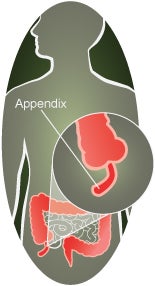 People between the ages of one and seventeen often get their appendix removed. The appendix is a projection off of our intestines. When bad bacteria overgrow in the appendix, it can become infected. The inflamed appendix is called appendicitis. If thereis too much inflammation the appendix can burst or rupture. Bacteria from the intestines spills into the abdominal cavity and causes more issues throughout the belly. To avoid rupture of an inflamed appendix, patients with appendicitis get it removed.
People between the ages of one and seventeen often get their appendix removed. The appendix is a projection off of our intestines. When bad bacteria overgrow in the appendix, it can become infected. The inflamed appendix is called appendicitis. If thereis too much inflammation the appendix can burst or rupture. Bacteria from the intestines spills into the abdominal cavity and causes more issues throughout the belly. To avoid rupture of an inflamed appendix, patients with appendicitis get it removed.
Another common remodeling procedure is repair of broken bones. We have bones throughout our body that provide support and protect our internal organs. When bones are placed under strong forces, they can break. Broken bones or fractures where the bone fragments are not aligned, need to be straightened to heal properly. Bone realignment sometimes requires surgery with the use of metal hardware, like screws and plates, to place the bones back together.
Smart Nanobombs
 Smart nanobombs are assigned to tissues. When they find the right tissue, they release the disease-fighting drug. Some, called biodegradable nano-capsules, are designed to find and attach to specific molecules within a tissue. This specificity allows smart nanobombs to attach to disease-causing cells. When the nano-capsule attaches or binds to its target cell, it releases medication.
Smart nanobombs are assigned to tissues. When they find the right tissue, they release the disease-fighting drug. Some, called biodegradable nano-capsules, are designed to find and attach to specific molecules within a tissue. This specificity allows smart nanobombs to attach to disease-causing cells. When the nano-capsule attaches or binds to its target cell, it releases medication.
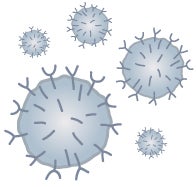 With traditional medication, drugs travel in the patient’s blood in order to get to the target tissue where they can act. While traveling in the body, drugs may attach themselves to tissues or molecules similar to those they are targeting. Attaching to unintended molecules is called non-specific binding. Binding to these molecules or special landing zones on cells called receptors may change other cellular processes and lead to side effects. This explains why certain medicines can affect a patient in a variety of ways. Smart nanobombs reduce non-specific binding. Because the drugs are not released until they reach the target tissue, they do not bind to receptors outside of the target tissue.
With traditional medication, drugs travel in the patient’s blood in order to get to the target tissue where they can act. While traveling in the body, drugs may attach themselves to tissues or molecules similar to those they are targeting. Attaching to unintended molecules is called non-specific binding. Binding to these molecules or special landing zones on cells called receptors may change other cellular processes and lead to side effects. This explains why certain medicines can affect a patient in a variety of ways. Smart nanobombs reduce non-specific binding. Because the drugs are not released until they reach the target tissue, they do not bind to receptors outside of the target tissue.
Smart Prosthetics
 Prosthetics are used to replace lost body parts. Traditional prosthetics don't always work very well. New, smart prosthetics act like real limbs to improve the lives of patients.
Prosthetics are used to replace lost body parts. Traditional prosthetics don't always work very well. New, smart prosthetics act like real limbs to improve the lives of patients.
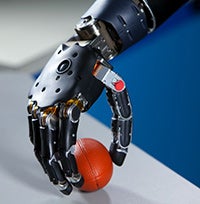 Smart prosthetics can integrate with appropriate body systems. They can also respond to stimuli, learn, self-correct, and self-repair. Smart prosthetics are wired to the patient’s brain to communicate sensory (touch) and motor (movement) information. This allows patients to control the prosthetic with just brain power
Smart prosthetics can integrate with appropriate body systems. They can also respond to stimuli, learn, self-correct, and self-repair. Smart prosthetics are wired to the patient’s brain to communicate sensory (touch) and motor (movement) information. This allows patients to control the prosthetic with just brain power
Transplant
 A healthy body needs its organs and tissues to work properly. But, some diseases can damage organs and tissues. These organs and tissues need to be replaced in order to restore their function in the body. Transplant therapy is the replacement of unhealthy tissues or organs with healthy specimens from the patient’s own body or from a donor. When the tissue is transferred from one body site to another in the same individual, it is referred to as an autograft. Skin autografts are used to treat severe burns. When a patient suffers a severe burn on part of their body, skin tissue can be transplanted from another healthy area. This will help the burned area heal and minimize scarring.
A healthy body needs its organs and tissues to work properly. But, some diseases can damage organs and tissues. These organs and tissues need to be replaced in order to restore their function in the body. Transplant therapy is the replacement of unhealthy tissues or organs with healthy specimens from the patient’s own body or from a donor. When the tissue is transferred from one body site to another in the same individual, it is referred to as an autograft. Skin autografts are used to treat severe burns. When a patient suffers a severe burn on part of their body, skin tissue can be transplanted from another healthy area. This will help the burned area heal and minimize scarring.
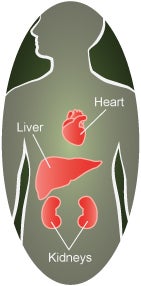 Allografts are transplants between humans. Kidneys are the most common allograft transplant, followed by liver and heart. A healthy person's organ is surgically transferred to replace the sick person's unhealthy organ. One major complication of allograft transplantation is immune rejection. The immune system works by identifying and attacking foreign intruders, like bacteria and viruses. If the patient’s immune system recognizes the new organ as foreign, it will mount an attack against it. In order to minimize transplant rejection, patients are matched to donors that have similar recognition molecules. When a patient and donor have well-matching tissues they are said to be histocompatible, and transplantation can proceed. Following transplant from another donor, patients are often placed on medication to suppress the immune system.
Allografts are transplants between humans. Kidneys are the most common allograft transplant, followed by liver and heart. A healthy person's organ is surgically transferred to replace the sick person's unhealthy organ. One major complication of allograft transplantation is immune rejection. The immune system works by identifying and attacking foreign intruders, like bacteria and viruses. If the patient’s immune system recognizes the new organ as foreign, it will mount an attack against it. In order to minimize transplant rejection, patients are matched to donors that have similar recognition molecules. When a patient and donor have well-matching tissues they are said to be histocompatible, and transplantation can proceed. Following transplant from another donor, patients are often placed on medication to suppress the immune system.
Transplantation medicine is very complex. There is also usually a shortage of healthy donor organs. There are not enough donor organs for all of the patients that need their damaged organs to be replaced. The use of 3D-printers to construct artificial organs is being explored as a way to make enough organs for transplants.
Read more about: Doctor Know
Bibliographic details:
- Article: Treatments
- Author(s): Dr. Biology
- Publisher: Arizona State University School of Life Sciences Ask A Biologist
- Site name: ASU - Ask A Biologist
- Date published:
- Date accessed:
- Link: https://askabiologist.asu.edu/treatments
APA Style
Dr. Biology. (). Treatments. ASU - Ask A Biologist. Retrieved from https://askabiologist.asu.edu/treatments
Chicago Manual of Style
Dr. Biology. "Treatments". ASU - Ask A Biologist. . https://askabiologist.asu.edu/treatments
Dr. Biology. "Treatments". ASU - Ask A Biologist. . ASU - Ask A Biologist, Web. https://askabiologist.asu.edu/treatments
MLA 2017 Style

Be Part of
Ask A Biologist
By volunteering, or simply sending us feedback on the site. Scientists, teachers, writers, illustrators, and translators are all important to the program. If you are interested in helping with the website we have a Volunteers page to get the process started.

